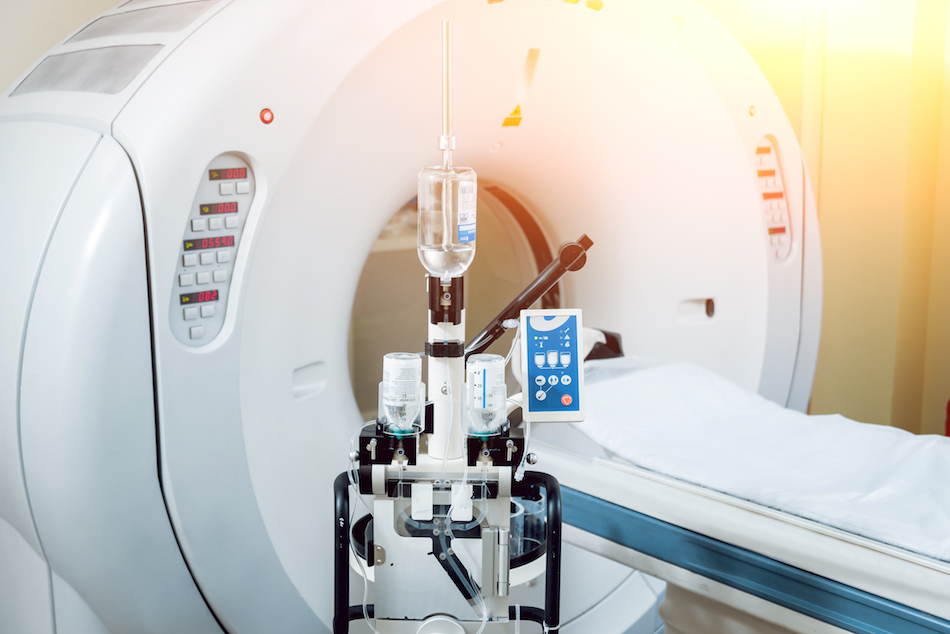A CT scan is an imaging examination that uses X-rays to create detailed images of the body. A computer is used to assemble a series of x-ray images to create detailed three-dimensional images of organs, tissues, bones and blood vessels in the body. Some CT scans require a contrast medium that allows a clearer view of organs and abnormalities.
CT is also called computerized axial tomography (CAT) or Cat-scan.
Almost all parts of the body can be studied by CT, since it provides detailed images of many different types of tissue such as these:
• Brain
• Respiratory tract
• Lung
• Bones
• Tissues
• Blood vessels
CT can help detect a wide variety of abnormalities or diseases that affect any part of the body. Computed tomography (CT) is recommended to:
• Diagnose cancer
• Study the abdomen, pelvis or chest
• Evaluate the size and location of tumours
• Evaluate the stage of a cancer
• Guide the doctor during a puncture or biopsy
• Plan a treatment
• Evaluate the effectiveness of cancer treatment by comparing the size of the tumour before, during and after treatment.
Duration of hospital stay
1 day.
The patient can leave the hospital after the examination.
Average length of stay
1 to 7 weeks.
Patients will have to wait for the results and have a follow-up consultation.

Every year, nearly 11 million patients go abroad in search of medical care. At MEDICAIM, we provide our patients with access to the best hospitals and doctors around the world. Contact us to learn more about your treatment options.
Ask for your free quote abroad
Start your medical stay by requesting a quote. Our customer service department will help you find the clinic that best suits your needs and get you a quote.
CT scans are usually performed in a hospital's radiology department or in a specialized centre as an outpatient procedure. The examination lasts up to 1 hour, depending on the size of the area to be examined.
If the person has received a sedative, the examination may take longer, 2 to 3 hours.
Special preparation may be required, depending on the body or structures examined:
• Do not eat or drink anything for a few hours before the exam
• Take a laxative
• Have an enema
• Remove all metal objects worn, including glasses, braces or jewelry
• Take a contrast agent.
Depending on the part of the body examined, a contrast agent can be administered:
• Orally
• Intravenously (injection into a vein in the hand or arm)
• By enema (injection of a liquid into the colon and rectum through the anus).
Since the machine produces x-rays, the technologist is in another room, but can still talk to the person via intercom.
If a woman is pregnant or believes she is pregnant, it is important that she notifies the radiology technologist or radiologist before taking any type of radiography.
If a contrast agent is to be used, it is important that a breastfeeding woman notifies it to the radiology technologist or radiologist.
The patient lies on a narrow table. Belts and cushions can be used to help him/her stay in the right position and still during the exam.
The table slides into a CT scanner that is shaped like a large rectangular box with an empty interior.
The camera moves through the device while taking many shots. A software gathers all these pictures to make 3D images of the body.
It is possible that you may have to hold your breath at times to make the pictures clearer.
Clicks or buzzes may be heard during the examination.
You can also see a light moving when the camera takes the pictures.
The images are processed and the patient will have to come back for a follow-up consultation to discuss the results.

The amount of radiation emitted during a CT scan is higher than during a routine x-ray. CT produces low levels of ionizing radiation, which can cause cancer and other abnormalities. However, the risk associated with each examination is low. All CT scans and other types of radiography are rigorously monitored and controlled to ensure that the radiation dose emitted is as low as possible. The benefits expected from x-rays must always outweigh any possible risk.
About 5% of people react to the contrast medium. The symptoms can be as follows:
• nausea
• wheezing breath
• shortness of breath
• metallic or bitter taste in the mouth
• itching or swelling of the face
MEDICAIM is looking for the best specialists for you and we will offer you several renowned doctors.
MEDICAIM organizes your entire stay for you: post-operative nursing care, biological follow-up, therapeutic, nutritional and psychological support.
Any additional questions? Ask your MEDICAIM doctor about it: careteam@medicaim.com
Some needs and conditions are more complex than others. In case of doubt, please send us additional information to establish a customized quote.
Ask for a quoteCertains besoins et pathologies sont plus complexes que d’autres. En cas de doute, faîtes-nous parvenir des informations complémentaires pour établir un devis sur-mesure.
Demander un devisEntrust us with your medical file and it will be examined by a specialist doctor. The goal?
Allow you to evaluate all your treatment options.